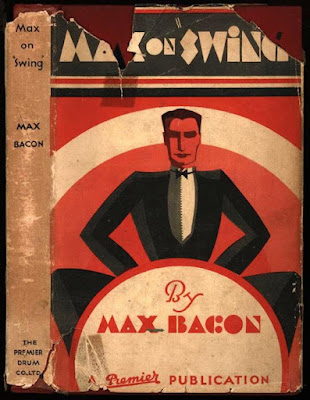A rare piece of jazz drumming history today, a long out-of-print drum manual on swing drumming by drummer, actor and comedian Max Bacon, originally published by the Premier Drum Company in 1934.
Download the .pdf version here:
...or here:
If I had to guess, I might believe that this is one of the very first jazz drumming manuals or instructional books ever published (ed. note: I know that Gene Krupa and Dave Tough had some books published in the 1930s but I'd have to check the dates...)
I recently came across this book and author via drummer British drummer Daniel Harding's blog.
Here's an excerpt from Max on "Swing" via Harding's website and I think that many of these words still resonate today:
What, then, is this “swing”, which is the very essence of successful rhythmic playing to-day? Is it rhythm ?
It is more than rhythm.
It is the very pulse of rhythm – that which beats within rhythm to give it life.
It is the very pulse of rhythm – that which beats within rhythm to give it life.
Unless the essential swing is there, the rhythm will cease to inspire: it may even cease to exist.
Swing is a very elusive thing, but there is no mistaking it when you hear it. It is a sense of rhythmic balance which moves the whole band as one unit. It is a steady sweeping movement, like the swing of the pendulum of a grandfather clock. To and from: to and from.
That is swing ; and until a band get knack of swinging together, that band will not be a success. The expression of the rhythm is of the same type that you see in that super swing acquired by skilled skaters, dancing upon ice – large regular sweeps.
Mind you, this swing is very difficult to acquire at first. It does not come all at once, even to the best musicians. I have often heard a bunch of well-known players get together for amusement and – experienced though they are – it will be quite a while before they begin to swing as a unit. In the same way, it sometimes happens that a band noted for its swing will lose it for a time. Lack of concentration, or over-tiredness is generally the cause.
But when once you get “into” the swing of the rhythm, you will find that you keep it, for the simple reason that a rhythmic movement, with its regular pulse, is the easiest to maintain.
What is the best way to acquire swing, you may well ask. First and foremost, it is a question of temperament: you must like it when you hear it and you must want to do it yourself. As you know, most dance drummers have become such because they were “drum-minded” ; they had in “in” them to become drummers. In just the same way, you must have it in you to feel that swing behind the rhythm. As I say, it is a question of temperament. It is, of course, partly what we call a gift. You must have the gift of a drumming mind. But it can most definitely be acquired to those who will.
There are several ways of helping yourself to get swing into your work. First and foremost, you must listen to those bands that are known to excel in this. Compare them with others and notice the difference. Then try and analyze their work and discover how this difference is produced. By this means, you will find yourself gradually “soaking your system” in swing until it enters your very blood and becomes part of you.
What is the best way to acquire swing, you may well ask. First and foremost, it is a question of temperament: you must like it when you hear it and you must want to do it yourself. As you know, most dance drummers have become such because they were “drum-minded” ; they had in “in” them to become drummers. In just the same way, you must have it in you to feel that swing behind the rhythm. As I say, it is a question of temperament. It is, of course, partly what we call a gift. You must have the gift of a drumming mind. But it can most definitely be acquired to those who will.
There are several ways of helping yourself to get swing into your work. First and foremost, you must listen to those bands that are known to excel in this. Compare them with others and notice the difference. Then try and analyze their work and discover how this difference is produced. By this means, you will find yourself gradually “soaking your system” in swing until it enters your very blood and becomes part of you.
Having thus acquired it, the best way to produce it is to play easily. Do not be strained or forced. And to do this, you must, of course, have a certain amount of technique…..
Remember that the drummer has a very important part to play in swinging the band: and a poor drummer cannot swing a band, even if it is a good one. And the reverse of this is equally true.
Remember that the drummer has a very important part to play in swinging the band: and a poor drummer cannot swing a band, even if it is a good one. And the reverse of this is equally true.
- Max Bacon from Max on "Swing" (1934)



No comments:
Post a Comment